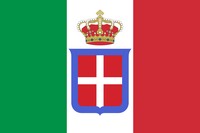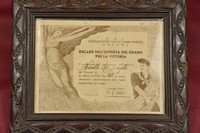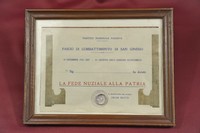Broken promises
At the beginning of the First World War, on 26 April 1915, while Italy was still neutral, "secret diplomacy" led to the signing of an agreement (the Treaty of London) in London between the Italian government and representatives of the Triple Entente, made up of the British Empire, France and Russia.
The pact included Italy's commitment to go to war within a month against Germany, Austria-Hungary, the Ottoman Empire and Bulgaria in exchange for substantial territorial compensation, which was not fully recognised by the Treaty of Versailles at the end of the First World War.
This gave rise to the feeling of "mutilated victory", which in Italy led to discontent and unrest, which was promptly exploited by the nascent Fascist Party.
L'economia ante seconda guerra mondiale

In the 1920s Fascism tried to make Italy economically independent from other countries:
- from an agricultural point of view, through the plans of the "Battle of Wheat" in 1925, to make the country self-sufficient in wheat production and to reduce the trade deficit in the balance of payments, and the "Bonifica Integrale" between 1928 and 1934, to reduce the incidence of malaria and to take land out of the marshes in favour of agriculture.
- From an economic point of view, between 1922 and 1925, a liberalist policy that weakened the presence of the State in the economic life of the country, with measures aimed at maintaining the consent of big capital to the Fascist regime. While this was in some ways favourable to the recovery of the economy, a number of alarming factors emerged, including an increase in domestic demand that caused the volume of imports to far exceed exports, thus triggering a worrying inflationary process. To curb this phenomenon, Mussolini announced a deflationary manoeuvre in 1926, fixing the exchange rate against the pound sterling, the reference currency at the time, at 90 lira in 1926, down from 150 lira in 1925. Exports fell sharply as a result, while monetary stabilisation benefited large companies but led to the bankruptcy of small and medium-sized enterprises or their absorption by more structured companies.
While this was in some ways favourable to the recovery of the economy, a number of alarming factors emerged, including an increase in domestic demand that caused the volume of imports to far exceed exports, thus triggering a worrying inflationary process. To curb this phenomenon, Mussolini announced a deflationary manoeuvre in 1926, fixing the exchange rate against the pound sterling, the reference currency at the time, at 90 lira in 1926, down from 150 lira in 1925. Exports fell sharply as a result, while monetary stabilisation benefited large companies but led to the bankruptcy of small and medium-sized enterprises or their absorption by more structured companies.
The internal economic difficulties were compounded by "external" ones when, as a result of the Great Depression, between 1929 and 1932 Italian production suffered a further contraction of between 15 and 25 per cent due to the financial problems caused by the cessation of international capital flows and the consequent lack of liquidity in industry, to which was later added the fall in demand caused by the worsening consumer credit crunch. Stocks lost more than a third of their value and unemployment rose sharply between 1932 and 1933. Thus began a period of internal recession, the social costs of which were so great that the poorer classes suffered a fall in nominal wages of up to 70 per cent between 1927 and 1935.
Faced with the difficulties facing both the banking and industrial systems, the state, in an attempt to avoid a total collapse of the economy, reversed its policy of liberalisation and, through the I.M.I. (Istituto Mobiliare Italiano) and the I.R.I. (Istituto per la Ricostruzione Industriale), created in 1931 and 1933 respectively, quickly became Italy's largest entrepreneur and banker. The role of the I.M.I. was to prevent the bankruptcy of Italy's three main commercial banks, which would have led to the collapse of the economy, and to manage the controlling stakes in the major industries in difficulty, whose shares were held by the banks as collateral for the loans they had granted. In this way, the I.M.I. helped them to recapitalise and to grant medium and long-term loans.
In 1937, two specialised structures were created within the I.M.I:
- the banking section, responsible for the management of the controlling interests resulting from the acquisition of the majority of shares in the three banks of national interest - Banca Commerciale Italiana, Banco di Roma and Credito Italiano - and for reorganising the banking system by regulating it and strengthening the supervisory role of the Bank of Italy, in accordance with Law 375 of March 1936.
- the industrial section, whose task was to transfer control of large Italian companies to private individuals or, where this was not possible because of the size of the investment required or the national interest, to retain control by financing them with funds provided by the Treasury or, above all, by issuing bonds, including convertible bonds.
In 1931, the monetary system known as the Gold Standard, which governed the international monetary exchange standard under which individual currencies were convertible into gold and vice versa and enjoyed a fixed exchange ratio on the basis of which the only standard was gold, was also finally abandoned. Basically, the gold standard said that the exchange value between currencies was firmly dependent on the ratio of the amount of gold, i.e. the gold reserves, of each issuing state, so that the amount of currency in circulation was proportionally linked to the total gold reserves of the country's central bank. After 1931, gold ceased to be the money of national economies and was used as a means of payment to settle international debts.
In 1933 the gold reserves of the Bank of Italy, the only Italian institution capable of issuing money, amounted to 561 tonnes, which had already fallen to 106 tonnes by the time the war broke out.
By the end of 1938, Germany's gold reserves stood at just over 25 tonnes, the United States at 1,200 tonnes and England at around 3,500 tonnes.
Public spending, at various times aimed at rescuing industry or military rearmament, was financed by increasing the public debt, including through the issue of public bonds, which were largely purchased by the national banks (controlled by the Treasury!), which in turn financed industry for production needs, also according to the needs of the regime, in the colonial period and the Spanish War. The Treasury would then give the money collected from the bond issues to the industries, which would repay the banks for the financing they had received. And the circle was complete. From 1934, the budget deficit had to be financed not only by public debt, but also by devaluing the lira, which led to inflation, but which was only contained by further severe wage restraint, which led to a fall in domestic demand.
In order to support the weaker sections of the population affected by the crisis, in 1935 the functions of the National Social Security Fund, which had been established in 1919 as a result of compulsory disability and old-age insurance, were significantly strengthened. In 1939, the National Fascist Social Security Institute, which had become a public body, began to deal with unemployment insurance, family allowances, wage supplements, etc. In 1943 it was renamed the National Social Security Institute.
 In October 1935, the League of Nations condemned Italy for the attack and invasion of Ethiopia and adopted sanctions prohibiting the purchase of products from Italy and the importation into Italy of products useful to the war effort. These measures, which proved to be very ineffective, nevertheless increased the sense of belonging among Italians. Thus began the "Gold for the Homeland" campaign, which was followed on 18 December 1935 by the "Day of Faith", when the population donated their wedding rings to help pay for the war in Ethiopia and to alleviate the hardships caused by the sanctions. The 37 tonnes of gold and 115 tonnes of silver collected further impoverished families. In 1936 the regime sanctioned, mainly for propaganda purposes, autarky, or the attempt to become completely independent from international markets by replacing imports with domestic products. Italy was (and always had been) a manufacturing country, an importer of raw materials and an exporter of manufactured and finished products, at that time mainly mechanical and heavy engineering, so much so that in the second half of the 1930s the sector, in which the I.R.I. accounted for just over 40 per cent of companies, saw its workforce double. Small businesses were also revalued and financed, particularly in the timber, clothing and agricultural sectors.
In October 1935, the League of Nations condemned Italy for the attack and invasion of Ethiopia and adopted sanctions prohibiting the purchase of products from Italy and the importation into Italy of products useful to the war effort. These measures, which proved to be very ineffective, nevertheless increased the sense of belonging among Italians. Thus began the "Gold for the Homeland" campaign, which was followed on 18 December 1935 by the "Day of Faith", when the population donated their wedding rings to help pay for the war in Ethiopia and to alleviate the hardships caused by the sanctions. The 37 tonnes of gold and 115 tonnes of silver collected further impoverished families. In 1936 the regime sanctioned, mainly for propaganda purposes, autarky, or the attempt to become completely independent from international markets by replacing imports with domestic products. Italy was (and always had been) a manufacturing country, an importer of raw materials and an exporter of manufactured and finished products, at that time mainly mechanical and heavy engineering, so much so that in the second half of the 1930s the sector, in which the I.R.I. accounted for just over 40 per cent of companies, saw its workforce double. Small businesses were also revalued and financed, particularly in the timber, clothing and agricultural sectors.
The lack of various raw materials due to international isolation, or the poor quality of products, goods or food due to autarky, led to the growth of the black market, as families became increasingly impoverished, people went hungry and tried to substitute a raw material for what they had, always coming up with something that bore only a vague resemblance to what was actually needed.
The war in Ethiopia in 1935, the intervention in Spain between 1937 and 1938, and the occupation of Albania in 1939 had already shown the limitations of the Italian armed forces, especially in terms of equipment, and the difficulties of meeting their costs. In 1939, "non-belligerent" Italy, courted by England, was opposed to entering the war: public opinion, the ruling class, including Ciano, Grandi and Victor Emmanuel III, who had never hidden his dislike of Hitler's Germany.
Then, in 1940, the inclined plane of fate led Italy ever faster towards disaster.
Let us briefly summarise the main events between 1938 and Italy's entry into the war: The annexation of Austria and the Sudetenland to Germany in 1938, the German non-aggression pact with the Soviet Union in August 1939, the stunning defeat of Poland in September 1939 without Italy being informed (the Pact of Steel had already been signed), the division of Poland between Germany and the Soviet Union in October 1939, the Soviet attack on Finland - to which Italy sent arms and aircraft - in November 1939, the strategic blitzkrieg that led to the occupation of Belgium, Holland and Luxembourg in May 1940, the invasion of France, the chaotic and searing flight of the British Expeditionary Corps from Dunkirk between 26 May and 3 June 1940, the German default on the Steel Pact, the attitude of the Upper Adige and the fear of annexation of South Tyrol after the June plebiscite, In 1939, Mussolini demanded that the construction of the Littorio Alpine barrier, begun in 1931, be speeded up on the former Austrian border, which had now become the border with Germany.
It is now difficult to understand what changed the course of events. The Pact of Steel had been signed in May 1939. Forgotten for a year by the Germans' request for an alliance, it would probably remain in a drawer for who knows how long. Mussolini wanted to sign it on the spur of the moment, as Ciano, then Foreign Minister, wrote in his diary, because some articles published in American newspapers were questioning the dictator's prestige. Then regret and the return of mistrust and doubt. There was probably no single factor that changed the balance between remaining "non-belligerent", trying to avoid the great risk of a German invasion and occupation of Italy, giving in to England's temptations, and the alternative: entering into a war alongside Germany that everyone knew, especially the General Staff, would be untenable in the medium to long term. Mussolini, as already mentioned, initially chose the path of "non-belligerence", which led England, usually quite arrogant, despite the correspondence between Mussolini and Churchill, in which it is alleged that the British statesman asked Mussolini to enter the war with Germany in order to mediate its claims, to a series of initiatives, including the naval blockade in the Mediterranean, which caused the coal crisis in Italy and brought Italy closer to Germany.
Thus, on 10 June 1940, Italy entered the war with its economic, financial and social fabric tested by years of crisis and recession, from which it struggled and slowly emerged, thanks in part to public investment in the colonies and, as in the rest of the world, in rearmament, which had revitalised industry and reduced unemployment; Research had lagged far behind technological development in industry, with the result that much of the equipment of all the armed forces was either left over from the First World War (individual weapons and artillery) or inadequate (armoured vehicles, tanks and much of the air force). Above all, the training of troops and, perhaps most seriously, officers was lacking.
Bibliography:
Web sites: archiviostoricoiri.it and bancaditalia.it

